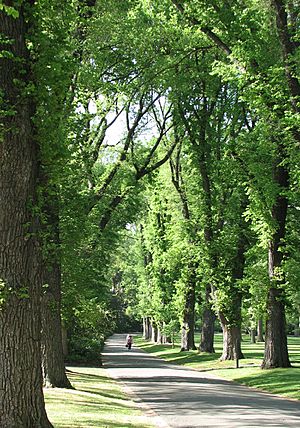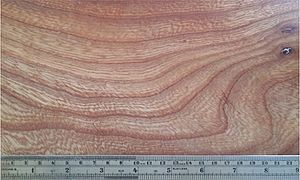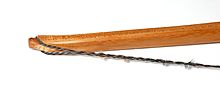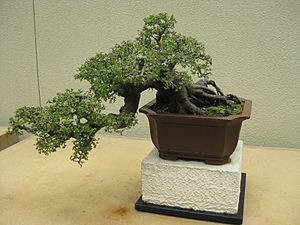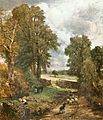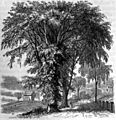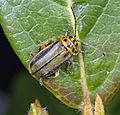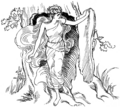Elm facts for kids
Quick facts for kids Elm |
|
|---|---|
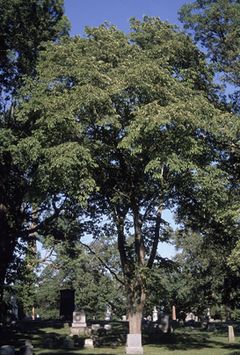 |
|
| Mature Slippery Elm | |
| Scientific classification | |
| Kingdom: | |
| Division: | |
| Class: | |
| Order: | |
| Family: | |
| Genus: |
Ulmus
|
| Species | |
|
See Elm species, varieties, cultivars and hybrids |
|
Elms are tall, beautiful trees found across the Northern Hemisphere. This includes places from chilly Siberia to warm Indonesia, and from Mexico to Japan. Most elms are deciduous trees, meaning they lose their leaves in the fall. Some are semi-deciduous, losing leaves only in certain conditions.
Elm trees have leaves that grow in an alternating pattern along the branch. Their leaves are usually pointed at the tip and a bit uneven at the base. The edges of the leaves are often saw-toothed.
Elm flowers are special because each flower has both male and female parts. This means they are hermaphroditic. Their flowers don't have petals and are pollinated by the wind. The fruit of an elm tree is a small, round, winged seed called a samara. Elms can take many decades to grow into a full-sized tree.
Contents
What Elms Look Like
Elm trees are known for their tall, often vase-like shape. They can grow very high, sometimes with a trunk that splits into a wide, open form.
Elm Leaves and Seeds
Elm leaves grow in an alternating pattern. They have simple edges or, more often, double-saw-toothed edges. The base of the leaf is usually uneven, and the tip is sharply pointed.
The fruit of an elm is a round, winged seed called a samara. These seeds are spread by the wind. They are often green, which helps them make food from sunlight even before the tree's leaves fully appear.
Elm trees can grow in many different types of soil and pH levels. However, most kinds need good drainage, meaning the soil shouldn't stay too wet.
-
'Sapporo Autumn Gold' elm in Florence, Italy
Elms in Gardens and Cities

For hundreds of years, people have planted elms to make places look beautiful. One of the oldest types, the narvan elm, was grown in Persia long ago for shade.
From the 1700s to the early 1900s, elms were very popular. They were planted in cities and towns to create lovely tree-lined avenues. People liked them because they grew fast and had many different leaf shapes and forms. Elms could also handle air pollution and their leaves broke down quickly in the fall.
In North America, the American elm was a favorite. It grew fast, adapted to many climates, had strong wood, and resisted wind damage. Its vase-like shape also meant it didn't need much pruning. In Europe, the wych elm and Field Elm were common.
The Challenge of Dutch Elm Disease
Around the time of World War I, a serious problem started: Dutch elm disease. This disease is caused by a fungus called Ophiostoma ulmi. It made many elm trees sick and caused them to die. The disease got even worse in the 1960s with a new, stronger type of fungus called Ophiostoma novo-ulmi. This was a very sad time for elm trees.
Elm Trees Today
Since the 1990s, things have gotten better for elms! Scientists have developed new types of elms that are much more resistant to Dutch elm disease. Now, there are over 300 known types of elms, both old and new. Even though some older types were lost, new ones are being planted.
However, some people are still careful about planting elms. This is because earlier disease-resistant trees released in the 1960s and 1970s didn't always do well. But the newer elms are much stronger.
Other Ways Elms Are Used
Elm Wood
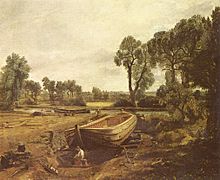
Elm wood is special because its grain is "interlocking." This means it's very hard to split, which makes it great for certain things. It was used for parts of wagon wheels, seats of chairs, and even coffins. In Japan, the bodies of large Taiko drums are often made from old elm trees because the wood won't split when nails are hammered into it.
Elm wood can also bend well and is quite flexible. Its long, straight trunks were perfect for making the keels (bottom parts) of ships. People who make bows also love elm wood. Many ancient bows found in Europe were made of elm. During the Middle Ages, elm was used for longbows when yew wood wasn't available.
Ancient writings show that elm wood was used a long time ago. In ancient Greece, parts of ploughs were made from elm.
Elm wood is also good at resisting rot when it's always wet. Because of this, hollowed-out elm trunks were used as water pipes in Europe during the medieval period. Elm was even used for the piers (supports) of the original London Bridge. However, it doesn't resist rot well when it's in contact with the ground.
Growing Grapes
The Romans, and later Italians, used to plant elms in their vineyards. They would cut the elms to about three meters tall. The elms grew quickly, had many small branches, provided light shade, and sent out new shoots from their roots. This made them perfect supports for grapevines. The cut branches were then used to feed animals or for firewood. People even talked about the "marriage" between the elm and the vine!
Medicinal Uses
The inner bark of the Slippery Elm (Ulmus rubra) has been used for a long time as a soothing medicine. It's still sold today in the United States as a nutritional supplement.
Animal Food
Elms have also been grown for a long time to feed livestock. Farmers would cut the leafy branches to give to their animals. This practice still happens in the Himalaya mountains today.
Energy Source
As we look for new energy sources, trees like elms are becoming more important. In Italy, scientists are developing very fast-growing elm types. These trees can grow more than 2 meters (6 feet) taller each year, making them good for producing bioenergy.
Food for People
During a big famine in Norway in 1812, the bark of elm trees was cut into strips and boiled. This helped many people in the countryside survive. Elm seeds are also very nutritious, with a lot of protein.
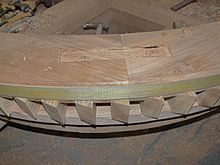
Bonsai
The Chinese elm (Ulmus parvifolia) is a popular choice for bonsai (the art of growing miniature trees). This is because it can handle being pruned very severely.
Protecting Elm Trees
In 1997, a project was started in the European Union to help save elm trees. The goal was to protect all the different types of elms and see how well they could resist Dutch elm disease. More than 300 different elm types were chosen and grown to be tested.
Famous Elm Trees
Many elm trees have become very large or famous for different reasons.
Elms in Art
Artists have often admired elms for their beautiful branches and leaves. They have painted them with great care. Elms appear in many paintings and studies by artists like John Constable, Ferdinand Georg Waldmüller, Frederick Childe Hassam, and George Inness.
-
Arthur Hughes, 'Home from Sea' [1862]
-
Ford Madox Brown, 'Work' [1863]
Images for kids
-
Lafayette Street in Salem, Massachusetts, showing the tall, tunnel-like effect of American elm avenues once common in New England (colorized postcard, 1910)
-
A row of Princeton elm trees at Scripps College in Claremont, California, which are somewhat resistant to Dutch elm disease
-
American elm trees along The Mall and Literary Walk in New York City's Central Park (2013)
-
Rows of American elm trees line a path south of the Lincoln Memorial Reflecting Pool in Washington, D.C. (November 11, 2006)
-
Elm in boat-building: John Constable, Boat-building near Flatford Mill, 1815
-
Under the elm, Brighton, 2006
-
A Rock elm (Ulmus thomasii) seedling growing
-
Root-suckers spreading from a field elm (Ulmus minor)
-
Aerial roots on a hybrid elm cultivar
-
'Pouch' leaf-galls on a wych elm (caused by an aphid called Tetraneura ulmi), Germany.
-
'Pimple' leaf-galls on a field elm (caused by a mite Eriophyes ulmi), Spain.
-
Ford Madox Brown, 'Work' [1863]
See also
 In Spanish: Olmos para niños
In Spanish: Olmos para niños










